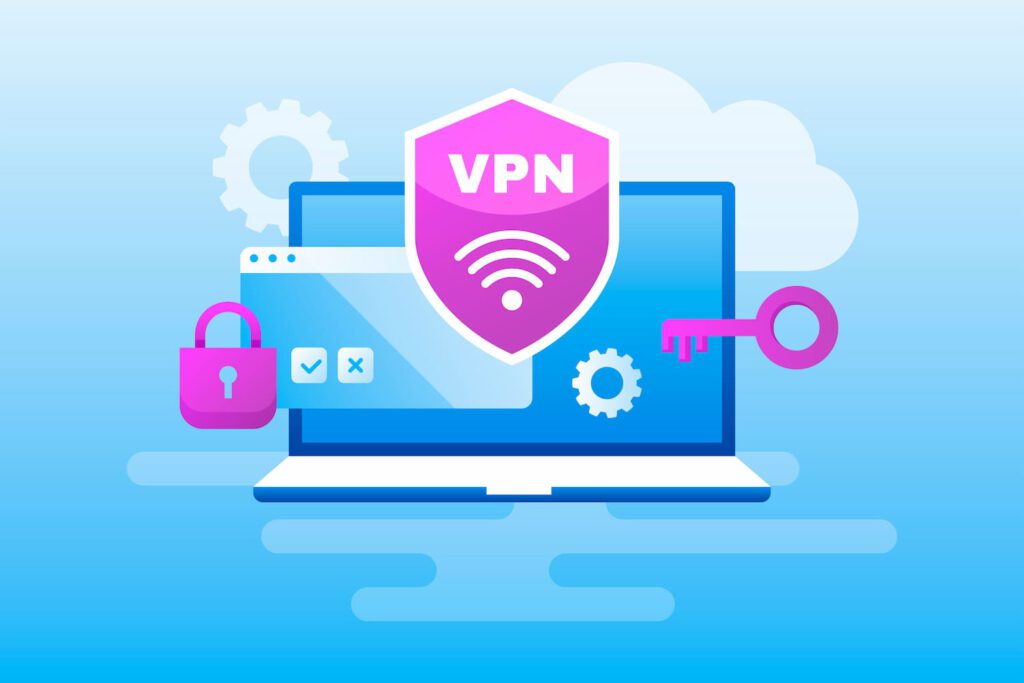Imagine you’re sending a postcard through the mail. Anyone who handles it can read what you wrote. Now, imagine putting that postcard inside a locked, metal box. Only you and the recipient have the key. This is the simplest way to understand how a VPN protects your information. It takes your open, readable data and puts it inside a secure, protected box for its journey across the internet.
This guide will walk you through exactly how that process happens. We will break down the journey of your data, from the moment you click a link to the moment a website loads on your screen. By understanding these steps, you will see exactly how a VPN creates a private channel for your online activity, shielding it from prying eyes.
The 8 Key Steps of How a VPN Works
When you connect to a VPN, a series of automated actions happen in seconds. Here is a detailed, step-by-step look at the process from start to finish.
Step 1: You Initiate a Connection
It all starts with you. You open your web browser and type in a website address, like www.example.com. On a normal internet connection without a VPN, your device would prepare to send this request directly to the website. But with a VPN active, the process changes immediately.
Step 2: The VPN App Intercepts Your Request
Before your request can leave your device, the VPN software on your computer or phone steps in. The VPN app acts like a digital gatekeeper. It catches your request to visit www.example.com and stops it from going directly to your Internet Service Provider (ISP). This interception is the first and most critical step in the process.
Step 3: Your Data Gets Encrypted
Now that the VPN app has your request, it puts it inside a secure digital package. This is the encryption step. The app uses powerful encryption standards, like AES-256, to scramble your data into an unreadable code. Your request to visit www.example.com is now a jumbled mess of characters. Even if someone could see this data, it would be meaningless without the unique decryption key.
Step 4: The Encrypted Data Travels Through the Tunnel
Your scrambled data packet is now sent from your device. It doesn’t go to the internet directly. Instead, it travels through a secure “tunnel” to a remote server operated by your VPN provider. This tunnel is a protected connection that shields your data from anything else on the network, like hackers on the same public Wi-Fi.
Step 5: The VPN Server Receives and Decrypts Your Data
Your encrypted data packet arrives at the VPN server. The server, which holds the decryption key, unscrambles your request. It now knows you want to visit www.example.com. This is the only point in the process where your data is temporarily unencrypted. This is why choosing a VPN with a strict no-logs policy is so important.
Step 6: The Server Acts on Your Behalf
The VPN server does two important things next. First, it strips away your original IP address, which is like your digital home address. Second, it attaches its own IP address to your request. Then, it sends your request to www.example.com. To the website’s servers, it looks like the request is coming from the VPN server, not from you. If the VPN server is in Germany, the website thinks you are in Germany.
Step 7: The Website Sends Data Back to the VPN Server
The website www.example.com processes the request and sends the website data back. But it doesn’t send it to your IP address. It sends it to the IP address of the VPN server, because that’s where it thinks the request came from.
Step 8: The Data Returns to You
The VPN server receives the data from the website. It immediately re-encrypts this data and sends it back through the secure tunnel to your device. Your VPN app receives the encrypted packet, uses the decryption key to unscramble it, and finally displays the website on your screen. This entire round-trip happens in a fraction of a second.
A Simple Analogy: The Secure Mail Service
To make this even clearer, let’s compare the VPN process to sending a package through a highly secure mail service.
| Your Action | The VPN Process Equivalent | The Secure Mail Service Analogy |
|---|---|---|
| You want to send a message. | You want to visit a website. | You write a letter to a friend. |
| The VPN app intercepts it. | The VPN client catches your request. | You give the letter to a secure mail service instead of the post office. |
| Your data is encrypted. | Your request is scrambled into code. | The mail service puts your letter in a locked, unbreakable box. |
| Data travels through the tunnel. | The encrypted packet goes to the VPN server. | The locked box is transported in an armored truck. |
| The server processes it. | The VPN server decrypts the request and sends it on. | The mail service’s central hub opens the box, sees the address, and puts it in a new envelope with their return address. |
| The website responds. | The website sends data back to the VPN server. | Your friend replies to the mail service’s address, not yours. |
| The data returns to you. | The VPN server encrypts the response and sends it back. | The mail service puts your friend’s reply in their locked box and sends it back to you in the armored truck. |
| You see the result. | The VPN app decrypts the data and shows you the site. | You receive the box, unlock it, and read your friend’s letter. |
Why This Step-by-Step Process Matters for Your Privacy
Understanding these steps reveals why a VPN is so effective at protecting you. Each step in the process adds a specific layer of security and privacy.
- Step 3 (Encryption) is your shield against hackers. Because your data is scrambled before it ever leaves your device, anyone on the same network—like at an airport or a café—cannot steal your passwords, credit card numbers, or private messages.
- Step 6 (Server Masking) is your shield against tracking. Because the website only sees the VPN server’s IP address, it cannot track your real location or link your activity back to you. This also prevents your ISP from seeing which websites you visit. All they see is a connection to the VPN server.
- Step 6 (Server Masking) is your key to freedom. By connecting to a server in a different country, you can make it appear as if you are browsing from that location. This allows you to bypass geo-restrictions and access content or services that are otherwise unavailable in your region.
Conclusion
A VPN works through a clear, methodical process of interception, encryption, and rerouting. It acts as a middleman that takes your data, locks it up securely, and sends it to its destination from a different location. This eight-step journey transforms a public and vulnerable internet connection into a private and secure one.
By breaking down each stage, you can see that a VPN is not magic; it is a well-designed system for protecting your digital life. It ensures that your online activities are your own business, safe from hackers, advertisers, and anyone else who wants to snoop. Understanding this process is the first step toward taking real control of your personal data online.


